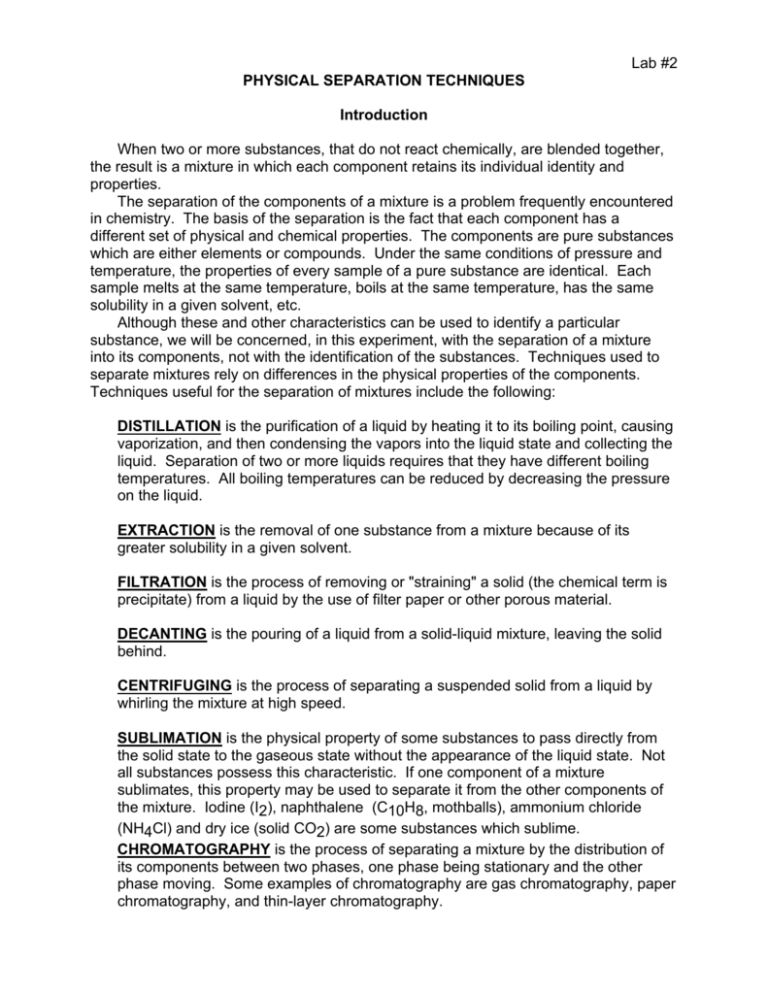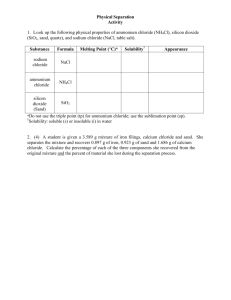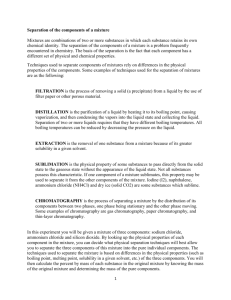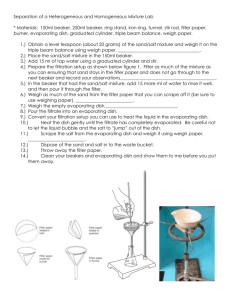Physical Separation
advertisement

Lab #2 PHYSICAL SEPARATION TECHNIQUES Introduction When two or more substances, that do not react chemically, are blended together, the result is a mixture in which each component retains its individual identity and properties. The separation of the components of a mixture is a problem frequently encountered in chemistry. The basis of the separation is the fact that each component has a different set of physical and chemical properties. The components are pure substances which are either elements or compounds. Under the same conditions of pressure and temperature, the properties of every sample of a pure substance are identical. Each sample melts at the same temperature, boils at the same temperature, has the same solubility in a given solvent, etc. Although these and other characteristics can be used to identify a particular substance, we will be concerned, in this experiment, with the separation of a mixture into its components, not with the identification of the substances. Techniques used to separate mixtures rely on differences in the physical properties of the components. Techniques useful for the separation of mixtures include the following: DISTILLATION is the purification of a liquid by heating it to its boiling point, causing vaporization, and then condensing the vapors into the liquid state and collecting the liquid. Separation of two or more liquids requires that they have different boiling temperatures. All boiling temperatures can be reduced by decreasing the pressure on the liquid. EXTRACTION is the removal of one substance from a mixture because of its greater solubility in a given solvent. FILTRATION is the process of removing or "straining" a solid (the chemical term is precipitate) from a liquid by the use of filter paper or other porous material. DECANTING is the pouring of a liquid from a solid-liquid mixture, leaving the solid behind. CENTRIFUGING is the process of separating a suspended solid from a liquid by whirling the mixture at high speed. SUBLIMATION is the physical property of some substances to pass directly from the solid state to the gaseous state without the appearance of the liquid state. Not all substances possess this characteristic. If one component of a mixture sublimates, this property may be used to separate it from the other components of the mixture. Iodine (I2), naphthalene (C10H8, mothballs), ammonium chloride (NH4Cl) and dry ice (solid CO2) are some substances which sublime. CHROMATOGRAPHY is the process of separating a mixture by the distribution of its components between two phases, one phase being stationary and the other phase moving. Some examples of chromatography are gas chromatography, paper chromatography, and thin-layer chromatography. In this experiment you will separate a three component mixture (containing sodium chloride, ammonium chloride and silicon dioxide) into the pure individual components. Knowing the mass of the original mixture and determining the mass of the pure components will allow you to calculate the percent by mass of each substance in the original mixture. The separation scheme used to separate the mixture is based on differences in the physical properties (such as boiling point, melting point, solubility in a given solvent, etc.) of the three components. Chemists frequently illustrate a separation procedure by means of a flow chart as depicted below. By looking up the physical properties of each component in the mixture, they can decide what physical separation techniques will best allow them to separate the mixture. In the Prestudy for this experiment you will look up the pertinent physical properties of the three components and fill in the missing substances and techniques shown as question marks. Mixture of NH4Cl, NaCl, SiO2 ???????????? ___________________________________ | ???????? ???????? ?????????? _________________________________________ | ???????? ???????? ????????? _________________ ??????? ??????? ????????? ________________ ???????? ???????? Lab #2 Procedure Obtain an unknown solid mixture from the instructor. 1. Separation of NH4Cl. Weigh a clean, dry, evaporating dish and accurately weigh the total solid mixture into it. Place the evaporating dish on a hot plate in the hood. Gently and slowly heat the mixture until the white fumes cease. Be patient. Depending on the amount of ammonium chloride in your sample, this could take quite a while. One hour would not be unheard of. Stir the mixture frequently to facilitate the sublimation of the ammonium chloride. This is crucial in order to obtain good results. If all the ammonium chloride is not sublimed at this point , your other results will also be off. After the white fumes disappear, continue heating the mixture until no white solid (NH4Cl) condenses on a stirring rod held above the evaporating dish. At this point all the NH4Cl should be sublimated. Allow the evaporating dish to cool and record its mass to find the mass of NH4Cl in the mixture. 2. Extraction of NaCl. Weigh a second, clean, dry, evaporating dish. Add between 5 and 7 mL of distilled water to the NaCl-SiO2 mixture and stir gently for 5 minutes. Carefully decant the liquid from the first evaporating dish into the second evaporating dish, leaving the solid behind. It is not crucial that all the liquid be transferred at this point. Add 5-7 mL more of distilled water to the first dish and gently stir for 5 minutes. Decant the liquid into the second evaporating dish. Repeat this process a third time with 5-7 mL more of distilled water. This process effectively extracts the NaCl (now in evaporating dish #2) from the SiO2 (in evaporating dish #1). Both components, however, are impure; the water mixed with each of them must be removed. 3. Drying of SiO2. Place the evaporating dish containing the wet SiO2 (dish #1) on a clay triangle assembly and slowly heat the mixture with stirring until the lumps break up and the sand appears dry. Now increase the flame and heat so that the bottom of the dish is red. Maintain this heat for 10 minutes. Allow the dish to cool to room temperature and weigh to find the mass of SiO2 in the original sample. 4. Drying of NaCl. Set the evaporating dish containing the NaCl-water solution on a clay triangle assembly. Gently heat the solution with a low flame at the beginning to avoid boiling the solution too vigorously and losing product. When most of the water is gone, reduce the heat to avoid splattering of the NaCl. It is advisable to place a watch glass over the dish at this point to avoid loss of NaCl. When no water is seen condensing on the watch glass then the sample is dry. Allow the dish to cool and record its mass to find the mass of NaCl in the original mixture. 5. Percent by Mass. Determine the percent by mass of each component in your mixture using the following formula: % of Component A = Grams of Component A x 100 Grams of Original Sample Alternate Procedure 1. Separation of NH4Cl. As written in the original procedure (set the hot plate on high). 2. Extraction of NaCl. Weigh a 400 or 600 mL beaker. Weigh a piece of filter paper. Add between 5 to 7 mL of distilled water to the NaCl-SiO2 mixture and stir gently for 5 minutes. Following the procedure outlined by the instructor (see the figure below), filter the sand-salt solution through the pre-weighed filter paper in the funnel into the preweighed beaker. The solution that comes through the funnel should be completely clear. (Do not stir the sand in the funnel. The wet filter paper is fragile and will rip if you stir it.) Add 5 to 7 mL more distilled water to the evaporating dish to remove the rest of the sand and pour this through the funnel. If all the sand is now removed from the evaporating dish, pour the third 5 to 7 mL portion of water directly on the sand in the funnel. If the sand is not all out of the evaporating dish, pour the last portion of water into it to remove the rest of the sand, making sure that all the water and sand gets into the funnel. 3. Drying of SiO2. Carefully place your wet filter paper cone in which the sand is contained onto a watch glass. There is no need to unwrap the cone. The instructor will then place the watch glass into a hot oven; do not go into the oven yourself. After approximately 30 minutes, the water should have all evaporated from the sand. The instructor will check and remove the dry sand and filter paper for you; do not go into the oven yourself. Allow the paper and sand to cool and then weigh them to find the mass of SiO2 in the sample. 4. Drying of NaCl. Set the beaker containing the NaCl solution on a hot plate. Gently heat the solution until the salt is dry. (Start at a low setting and then increase as the water evaporates.) Make sure that all the condensation is gone from the sides of the beaker. If the salt appears to be dry but there is still water on the beaker walls, see the instructor. If the salt pops out of the beaker, carefully remove the beaker from the hot plate and see the instructor. When the beaker is cool (check the bottom), weigh it to find the mass of NaCl in the original mixture. ring stand small iron ring The tip of the funnel should touch the side of the beaker for maximum flow rate. Lab #2 NAME ________________________________________SECTION # ____________ Data and Calculations Unknown Number _______________________________ 1. Mass of dish #1 plus original sample ___________ 2. Mass of evaporating dish #1 ___________ 3. Mass of original sample ___________ 4. Mass of dish #1 plus NaCl and SiO2 5. Mass of NH4Cl in original sample 6. Mass of dish #1 plus dry SiO2 7. Mass of SiO2 in original sample ___________ ___________ ___________ ___________ 8. Mass of dish #2 plus dry NaCl ___________ 9. Mass of evaporating dish #2 ___________ 10. Mass of NaCl in original sample ___________ Calculations: Show all work 1. Percent NH4Cl in the original sample. 2. Percent SiO2 in the original sample. 3. Percent NaCl in the original sample. 4. Percent lost. Lab #2 NAME ________________________________ SECTION # ______________ Prestudy Physical Separation Techniques 1.(5 points) Using the CRC Handbook of Chemistry and Physics or other suitable references, look up the following physical properties of ammonium chloride (NH4Cl), silicon dioxide (SiO2, sand), and sodium chloride (NaCl, table salt).(5 points) Physical Properties Substance Sodium Chloride (Table Salt) Ammonium Chloride (Sal ammoniac) Silicon Dioxide (Sand) Formula Melting Point (°C) Solubility* Appearance NaCl NH4Cl SiO2 * Solubility: Grams of solute per 100 g of water 2.(1 point) Using the above physical properties, complete the flow chart given on the second page of this lab by giving the reagents and/or conditions necessary to affect each indicated separation step and how the components will be separated. Use the other side of this paper for your chart. 3.(4 points) A student is given a 6.216 g mixture of iron filings, calcium chloride and sand. He separates the mixture and recovers 2.524 g of iron, 1.932 g of sand and 1.523 g of calcium chloride. Calculate the percentage of each component he recovered from the original mixture and the percent of material he lost during the separation process.





![CHEMISTRY SEMESTER ONE LAB [number] optional lab](http://s3.studylib.net/store/data/007492073_1-7f26dd79b994478028b46db679517ff3-300x300.png)